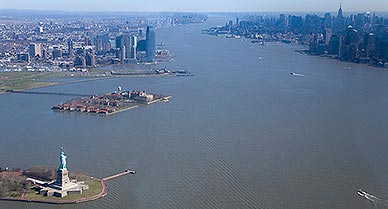Loot valued at $20 million lies off the coast of Staten Island, and Ken Hayes is on the hunt for the sunken silver bullion
 Among the old-timers casting for stripers along the Arthur Kill between Staten Island and New Jersey talk tends to return to a few well-thumbed topics. The most intriguing of these is the tale of the silver ingot that once snagged in the eel trident of the old Indian fisherman named Blood. From there, conversation invariably turns to the Lost Guggenheim Treasure.
Among the old-timers casting for stripers along the Arthur Kill between Staten Island and New Jersey talk tends to return to a few well-thumbed topics. The most intriguing of these is the tale of the silver ingot that once snagged in the eel trident of the old Indian fisherman named Blood. From there, conversation invariably turns to the Lost Guggenheim Treasure.
On the still, moonlit night of September 26, 1903, a tug urged the barge Harold out of what’s today the South Street Seaport and south past the Statue of Liberty. The Harold’s load that night was nearly 7,700 silver-and-lead bars. They were destined for the glowing Asarco smelters of Perth Amboy, New Jersey. The silver, and the smelters, belonged to the Guggenheim family, which had made its fortune in mining and smelting.
The cargo never arrived, at least in one batch. Somewhere in the Arthur Kill tidal strait the Harold tipped, sending most of the silver bars to the bottom. The barge’s deckhands—“dumbest skunks I ever had to do with,†the salvage company’s owner later told the New York Times—didn’t notice until docking at dawn. A secret salvage effort recovered about 85 percent of the bars, but that still left up to 1,400 “pigs†unfound. Today they could be worth $20 million.
One morning last fall, Ken Hayes set out to find himself some sunken treasure—that is, if no one got to Hayes, or to the treasure, first. Hayes is president and founder of Aqua Survey, a Flemington, N.J., company that usually grabs sediment from the bottom of waterways for clients like the U.S. Army Corps of Engineers. In recent years Aqua Survey also has gained a reputation for looking for less mundane things someone has lost underwater: Spanish doubloons off Key West. Fighter planes in the Bermuda Triangle. UFOs off Catalina Island.
The Guggenheim silver is Hayes’ personal obsession, however—which explains why Hayes was a little antsy to get started. It was eight o’clock in the morning at a boat launch at Sewaren on the Jersey side, less than two miles from the former Asarco smelters, and his three boats were stuck in traffic on Interstate 278. A documentary film crew burned the time taking B-roll of Hayes walking toward the water, looking pensive.
Finally the three boats arrived. The flotilla motored out toward Story’s Flats, a promising shallows where the channel bends like a quotation mark. It was a fine day to be on the water, even the Arthur Kill, which possesses a certain rusting Ozymandian grandeur: On the Jersey shore a beached ferry lay on its side, its bones bleaching in the October sun. Beside it the piers of the Hess tank farm were cushioned with a Detroit of used tires. A stained smokestack manufactured bright white clouds and sent them off over Fresh Kills Landfill.
As the boats positioned over their first target, Hayes, a jocular 57 year-old whose white beard, glasses and pebbled Clarkses give him the appearance of a college engineering professor, tried to temper expectations, including his own. Like any self-respecting treasure hunter Hayes had his own treasure map—created by sweeping the area with a souped-up metal detector whose software has been trained to ignore iron—but there was no guarantee that the map’s 255 dots were, well, treasure. “It could be aluminum cans, it could be specialty alloy rims from cars—you name it. Look, for years fishermen didn’t bring litter bags,†said Hayes, who with his employees has been surveying and investigating targets since 2006, spending several weeks annually on the quest.
A man motored up in a boat as white as a new tennis shoe.
“Is it silver or gold you’re looking for?†he called out.
“I’ll take either,†Hayes answered. The man said he was a retired marine patrolman from the 1980s, and he and Hayes swapped rumors. Before he left the retiree said, “You know, you better be careful, you might bring up Jimmy Hoffa.â€
 Once the boat was anchored in place, Hayes took what looked like an electrified pole-vault pole and began to prod through a window-sized hole in the deck. With this detector he prodded down through the water, down through a century’s worth of tidal muck and dioxins that the crew had nicknamed “black mayonnaise.†Meanwhile, inside the wheelhouse Mark Padover watched a laptop screen for a spike in the readings. This prodding continued for a long time. An observer noted that hunting for sunken treasure is not as swashbuckling in real life as when Johnny Depp does it at the Cineplex. Hayes handed off the pole to a crewmate and sat down on the deck. The black-mayo-prodding went on.
Once the boat was anchored in place, Hayes took what looked like an electrified pole-vault pole and began to prod through a window-sized hole in the deck. With this detector he prodded down through the water, down through a century’s worth of tidal muck and dioxins that the crew had nicknamed “black mayonnaise.†Meanwhile, inside the wheelhouse Mark Padover watched a laptop screen for a spike in the readings. This prodding continued for a long time. An observer noted that hunting for sunken treasure is not as swashbuckling in real life as when Johnny Depp does it at the Cineplex. Hayes handed off the pole to a crewmate and sat down on the deck. The black-mayo-prodding went on.
“Contact!â€
“When you hit it, it jumps!†Padover called out from in front of the computer screen.
“Well, I guess we get Pete’s tool out and try to bring it up,†Hayes says. To haul 75-pound bars out from under 96 years’ worth of muck, machinist Pete Davis had designed an 11-foot harpoon with a nasty-looking screw at one end and a big drill at the other. (Davis’ harpoon two years earlier, powered by a .38 Special, had proven dramatic if ineffectual.)
“So if we latch onto a 900-pound piece of metal, how do we detach from it?†someone asked. A discussion involving hacksaws ensued.
“Let’s fish,†Hayes said, seeming a little anxious for results.
Drilling commenced. The harpoon was winched up, but with no silver bar attached. Hayes groaned and lay back on the deck and pulled his ball cap over his eyes. Everyone broke for lunch.
Now another boat appeared. The crew recognized it. “When we were out in August they came out and circled our boat for hours. They said they were looking for the silver, too, and they asked us if we wanted to collaborate,†Hayes said. The boat now circled again, as if stalking, then anchored a few hundred yards away and would remain there all day, doing nothing. Occasionally the documentary film crew would film a man on the boat, and the man on the boat would film the film crew filming him.
After lunch, somebody said, “Hey! There’s someone on the shore.†And there was—on the Staten Island side, dressed in black and armed with binoculars. (An informant? A security guard?) But when everybody looked his way, the man in black ducked behind some bushes.
The promise of $20 million tends to foster this kind of vaguely menacing behavior. When Hayes first started looking for the silver, he said he got several phone calls from parties who felt he was horning in on a locals’ opportunity, and the calls urged him to abandon his hunt. Once while he was diving in Bonaire, off the South American coast, his cell phone rang.
“Maybe you’ve seen ‘The Sopranos,’†the caller said.
“No,†Hayes replied, “but I do like ‘Curb Your Enthusiasm.’â€
The day lengthened. The probing continued in new spots, without success. “Well, we know where it’s not,†he said. “Ten square feet at a time, we’ll know where it’s not.â€
The sun slumped low toward the old Asarco smelters. It was time to give up for today.
But Hayes and company were hardly relinquishing the quest. Over the winter they developed a sampling device that can plunge deep in the mayonnaise to collect a small flake of metal from suspected silver bars, “much the same way a surgeon would biopsy a tumor,†Hayes said.
Come spring, they’ll be out on the Arthur Kill, poking and prodding at targets again. If the tests say there’s silver down there, you can bet they’ll be back soon, ready to haul it up.